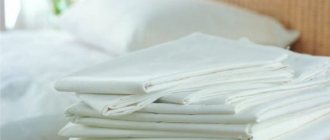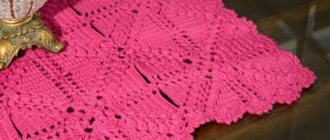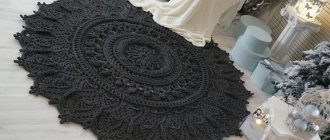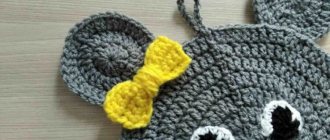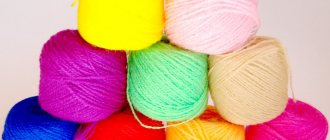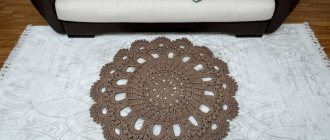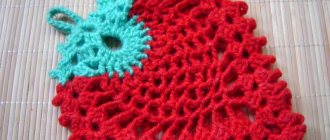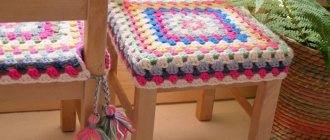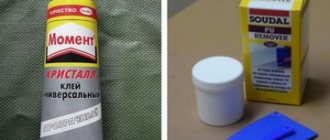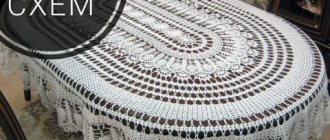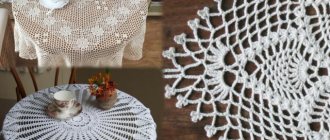Despite the popularity of the modern minimalist style in the interior, many housewives prefer the traditional interior decoration of their rooms. Knitted napkins are an integral part of it. They add the finishing touches to a homely atmosphere of warmth and comfort. But handmade products themselves do not hold their shape well and have a somewhat untidy appearance. This problem can be solved by starching. Let's figure out how to starch a crocheted napkin using starch, sugar, gelatin and glue.
Why starch napkins?
[blok_1_h2]
To create napkins, cotton threads of different thicknesses are used - “Iris”, “Snowflake” and others. They are produced in pure form and with the addition of various fibers - viscose, silk, lurex. Products made from mercerized cotton look beautiful. It undergoes a special treatment, as a result of which it acquires shine, wrinkles less and becomes stronger.
Regardless of the material, the product wrinkles during the knitting process. In addition, due to the openwork weaving, it does not hold its shape. During starching, the fibers of the napkin are covered with a thin film, as a result:
- their density and elasticity increases;
- slight whitening occurs;
- the threads become less susceptible to contamination - the film prevents dust and moisture from penetrating deeper.
When considering how to starch a knitted product, you need to know what can be useful for this:
- starch;
- sugar;
- gelatin;
- PVA glue.
Note: Do not starch napkins made of synthetic, silk or wool fibers, as well as dark-colored items. Such processing can lead to disruption of the silk structure. Wool and synthetics do not accept starch. And on dark napkins there are whitish spots.
PVA glue
A long-term result is one of the advantages of this method, but it is worth remembering that such a solution creates a high degree of hardness and cannot be used for underwear and bed linen.
Napkins properly treated with PVA glue will become elastic and rigid.
It is necessary to prepare a solution in the following ratio: a glass of water and half a glass of glue. This method is relevant when it is necessary to give a clear shape. To do this, dip a crocheted napkin into the mixture, wring it out and, if necessary, pull it into the desired shape.
This way you can create a napkin vase.
Traditional recipe with starch
[blok_2_h2]
The answer to the question of how to starch a crocheted napkin is simple - you need to prepare a paste from water and starch and hold the product in it. Potato processing product is usually used as a raw material. It is inexpensive, gives the solution a thick consistency, and also has a whitening effect. But you can also use starch from rice or corn. It is worth considering that they have a lower viscosity, so more of them are required.
The final hardness of the product depends on the concentration of the starch solution. Main methods:
- Soft. Water – 1 liter, starch – 1 small spoon. Used to add elasticity to napkins, the ends of which should hang down, knitted tablecloths, and curtains.
- Average. Water – 1 liter, starch – 1 large spoon. It is used if the problem arises, how to starch lace, openwork collar, cuffs, napkins.
- Hard. Water – 1 liter, starch – 2 large spoons. Allows you to give the product hardness and a clear shape. Suitable for small items, individual parts, vases, plates, flowers and other crafts created using openwork knitting.
The process of creating a solution and starching napkins is the same for all methods.
Stages of preparing the paste:
- Dilute starch with cold water (a small amount). Mix thoroughly so that there are no lumps. If they appear, filter the solution. Its texture should resemble liquid sour cream.
- Boil the rest of the water. Pour starch into it in a thin stream. Stirring constantly, bring the liquid to a boil.
- Turn off the fire. Leave the paste to cool to 30-35°.
Important: If the starch has foreign impurities, it is necessary to fill it with water without heating, mix and let stand for a while. Then you should drain the dirty water. The steps must be repeated until the substance becomes pure.
Let's look at how to starch a knitted napkin so that it takes on a beautiful shape. Algorithm of actions:
- Pour the cooled paste into a bowl.
- Dip a clean and bleached napkin into it so that the threads are completely saturated.
- Wait a while. It is selected depending on the type and thickness of the fibers. Thin threads - 5-7, medium - 10, thick - 15 minutes.
- Pull the napkin out of the paste. Squeeze lightly.
How to starch bedding and clothes in a washing machine
To starch things in the washing machine, you need to add a small amount of adhesive liquid to the conditioner compartment and start the usual washing cycle
Ready-made starching compositions are sold in household chemical stores - some are applied to the fabric before ironing, others during washing. Starching bedding and linen in the washing machine is as easy as shelling pears:
- to begin with, prepare a “soft” starch solution according to the above-described scheme;
- the composition is poured into the engine compartment for the air conditioner;
- The washing machine toggle switch is set to rinse mode;
- after the process is completed, the laundry is taken out, shaken, and dried;
- The machine is wiped from the inside and ventilated.
When starching in a washing machine, special synthetic liquids are often used, for example, based on polyvinyl acetate, which cope with the task no worse. Additionally, you should not use any conditioners.
A starch agent that is added directly during washing
To starch clothes and table linen made from various types of fabric, a solution of the required composition and concentration is prepared and poured into the machine as described above.
Other recipes with starch
[blok_3_h2]
For starching napkins and other openwork products, starch can be supplemented with various components - salt, milk, sugar, borax, talc. Textile processing is carried out according to the previously described scheme.
Salt
Salt gives a glossy shine to the threads. Preparation of the solution:
- Make a paste as described above.
- While it's hot, add a pinch of salt and mix thoroughly.
Milk
Milk provides a matte finish to knitted items and increases the volume of the fibers. For the solution you will need 1 liter of low-fat milk and 1 large spoon of rice starch. Stages:
- Combine starch and 1/2 cup milk (cold). Stir.
- Boil the remaining milk. Add starch liquid to it, stirring constantly. After boiling, turn off the heat.
Sugar
Sugar increases the hardness of the starch solution. You will need 3 large spoons of sugar, 1 large spoon of starch and 1 liter of water. Algorithm:
- Heat 1 glass of water. Dissolve sugar in it.
- Pour 1 cup of cold water over starch. Mix.
- Boil the rest of the water. Pour sugar syrup and starch into it. Boil. Remove from heat.
Gloss-starch
Let's find out how to hard starch a decorative crocheted napkin with starch and give it shine. Gloss-starch is intended for this purpose. Components:
- rice starch - 5 tablespoons;
- talc – 3 tablespoons;
- borax powder – 1 tablespoon;
- cold water.
Cooking and starching steps:
- Connect all components. Add a little water to get a creamy consistency.
- Dampen a brush or piece of cloth in the solution. Process the product or its individual parts.
- Iron immediately with a warm iron through cheesecloth.
Dry method
If you do not want to cook the paste, you can use the dry processing method. Action plan:
- Place the napkin on a sheet of white thick paper. It is better to secure the edges of the product with pins.
- Sprinkle a thin, even layer of starch over it.
- Spray water from a spray bottle on top.
- Cover the napkin with a clean white paper sheet and iron it with a not too hot iron or leave it for 2-3 hours to dry naturally.
You can buy an aerosol with starch in the store. Just sprinkle it on a damp cloth and iron it through a layer of fabric with a warm iron. The method is very simple, but gives a short-term effect.
Cold way
This method can be used if there is no need to give the product increased rigidity. Procedure:
- Stir starch in cold water, the proportions are the same as when preparing the solution using the hot method;
- stir thoroughly, you should get a suspension without lumps, if this cannot be achieved, you need to strain the solution through a sieve;
- place the product in a cold solution for 30-40 minutes;
- squeeze and dry, giving the napkin the desired shape.
After this treatment, the napkin will remain soft, the material will only be slightly compacted.
Processing without starch
[blok_4_h2]
You can shape a napkin, lace or other knitted product without starch. Alternative options:
- Sugar . Pour 3 cups of sugar with 1.5 cups of water. Cook until the crystals are completely dissolved. Immerse a napkin in the syrup for a few minutes. This method of processing textiles can attract insects and rodents to it.
- PVA glue . Combine glue and water in a 1:1 ratio. Mix. Immerse the product in the solution. Wait until the fibers are completely saturated and pull it out. This method is suitable for hard starching things that do not come into contact with food and skin - a snowflake, a vase, a decorative plate made of thread.
- Gelatin . Pour 1 large spoon of gelatin into 100 ml of warm water. Stir and leave to swell for 5-10 minutes. Heat in a bathhouse until the grains dissolve. Add 200 ml of water, bring to a boil. Cool. Soak a napkin in the solution. The advantage of gelatin is that, unlike starch, it does not crumble, which means it is more convenient for them to process bulky products.
Dry method
You can not soak the napkin in the paste, but treat it in another way. The product will be of medium hardness.
- lay the napkin on a flat surface, you can secure the edges with pins;
- through a strainer, evenly sprinkle the product with starch, trying to cover it evenly;
- spray the products with water from a spray bottle, the starch should be slightly moistened, no more;
- Allow the napkin to dry completely and shake off any excess starch.
When using this method, starched napkins do not retain their rigidity for long, so treatment must be carried out more often than when using conventional soaking methods.
Tips for drying and ironing
[blok_5_h2]
After soaking the napkin in starch or other solution, it must be laid out on a flat surface. For example, you can place it on an ironing board with a terry towel on it. If glue was used, then the fabric should be covered with cling film.
It is advisable to secure the edges of the product with pins so that it holds its shape. All patterns should be straightened and fixed while the napkin is wet. If there is fringe on it, it needs to be combed and laid out evenly.
It is better to dry the product not in direct sunlight, but in a ventilated room. A slightly damp cloth needs to be ironed with a warm iron through several layers of gauze. It is important to act quickly, but carefully so that the edges do not wrinkle. The iron should not be too hot, otherwise the threads will turn yellow.
If you need to make a vase or plate from a knitted napkin, you should take a base for giving the shape - a bowl, glass, bottle. Cover the outside of the item with cling film. Place a damp napkin soaked in starch (gelatin, glue, sugar) over it and leave until completely dry. This may take up to 24 hours.
Knitted napkins and various decorative items made from them are a classic interior decoration. Handicraftsmen spend a lot of time and effort creating such products. Treatment with starch or other means is an important final step to give the textiles a shape and a neat appearance. The effect lasts until the first wash. It is not recommended to starch synthetics, wool, silk, floss and dark items.
Possible mistakes
When performing work, you can make mistakes that will reduce the results of your work to zero. Helpful Tips:
- You cannot starch napkins knitted from floss, silk and synthetic threads, or wool. Only products made from cotton or linen threads tolerate processing well;
- It is not recommended to use a gelatin solution for processing white napkins, they may turn yellow;
- Treated products should not be dried on a radiator; high temperatures cause them to acquire a yellowish tint;
- Yellow spots can also appear when ironing with a very hot iron, so it is recommended to iron the product through gauze;
- if the edges are decorated with fringe, then after processing and drying, it is recommended to hold the fringe over steam and comb it, then it will not stick out like a stake.
If you plan to use knitted napkins to decorate your interior, you should learn how to starch them in different ways. It must be remembered that when washed or wet, the starch film will be destroyed, and the napkin will lose its shape and the processing will have to be repeated. Such napkins can only be used in dry rooms. If the humidity is high, the napkins will not only lose their shape, but can also become fertile ground for the growth of mold.
Ready solutions
If you don’t want to waste time preparing a starch solution, use what the stores offer! How to starch fabric using ready-made products? After checking the instructions, add the starch solution to the washing machine during the last rinse.
You can also purchase starch sprays designed for use during ironing. Some of them have additional benefits such as whitening, antistatic effect, etc. Starch spray is an excellent solution for starching clothing parts, such as collars or cuffs.
Aerosol
The most modern and fastest method is an aerosol. You can simply and effectively starch a small item in a short time; just spray the contents of the can evenly onto a crocheted napkin. Rules for spraying the aerosol: shake the can well and tilt it slightly, apply evenly to the product at a distance of 25-30 cm.
Unlike other methods, aerosol can be used on many types of fabric.
The product is simply sprayed onto a damp knitted item and ironed.

